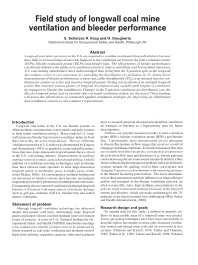Mining Publication: Field Study of Longwall Coal Mine Ventilation and Bleeder Performance
Original creation date: January 2012
Longwall coal mine operators in the U.S. are required to ventilate multipanel longwall districts, but may have little or no knowledge about what happens to the ventilation air between the inlet evaluation points (IEPs), bleeder evaluation points (BEPs) and bleeder fans. The effectiveness of bleeder performance can directly influence the ability of a ventilation system to remove and dilute coal bed methane emissions. U.S. coal mining stakeholders have acknowledged their belief that the T-junction split at the longwall face tailgate corner is very important in controlling the distribution of ventilation air. To obtain direct measurements of bleeder performance, a tracer gas, sulfur hexafluoride (SF6), was released into the ventilation air stream on active and inactive longwall panels. Testing was performed on multiple longwall panels that included various phases of longwall development and variable path lengths of ventilation air transport to bleeder fan installations. Changes in the T-junction ventilation air distribution over the life of a longwall panel, and its variable effect on panel ventilation airflow are discussed. These findings will assess the effectiveness of commonly applied ventilation strategies for improving air distribution and ventilation controls to meet statutory requirements
Authors: SJ Schatzel, RB Krog, HN Dougherty
Peer Reviewed Journal Article - January 2012
NIOSHTIC2 Number: 20040514
Trans Soc Min Metal Explor TP-10-040, 2012 Jan; 330:388-396
See Also
- A CART Technique to Adjust Production from Longwall Coal Operations under Ventilation Constraints
- Coal Bed Discontinuity Effects on the Production of Degasification Boreholes and on Emissions During Longwall Mining
- Development and Application of Reservoir Models and Artificial Neural Networks for Optimizing Ventilation Air Requirements in Development Mining of Coal Seams
- Guidelines for the Prediction and Control of Methane Emissions on Longwalls
- MCP - Methane Control and Prediction - 2.0
- Methane Emission Rate Studies in a Central Pennsylvania Mine
- Modeling and Prediction of Ventilation Methane Emissions of U.S. Longwall Mines Using Supervised Artificial Neural Networks
- A New Methane Control and Prediction Software Suite for Longwall Mines
- Prediction of Longwall Methane Emissions and the Associated Consequences of Increasing Longwall Face Lengths: A Case Study in the Pittsburgh Coalbed
- Reservoir Modeling-Based Prediction and Optimization of Ventilation Requirements During Development Mining in Underground Coal Mines
- Content source: National Institute for Occupational Safety and Health, Mining Program


 ShareCompartir
ShareCompartir
